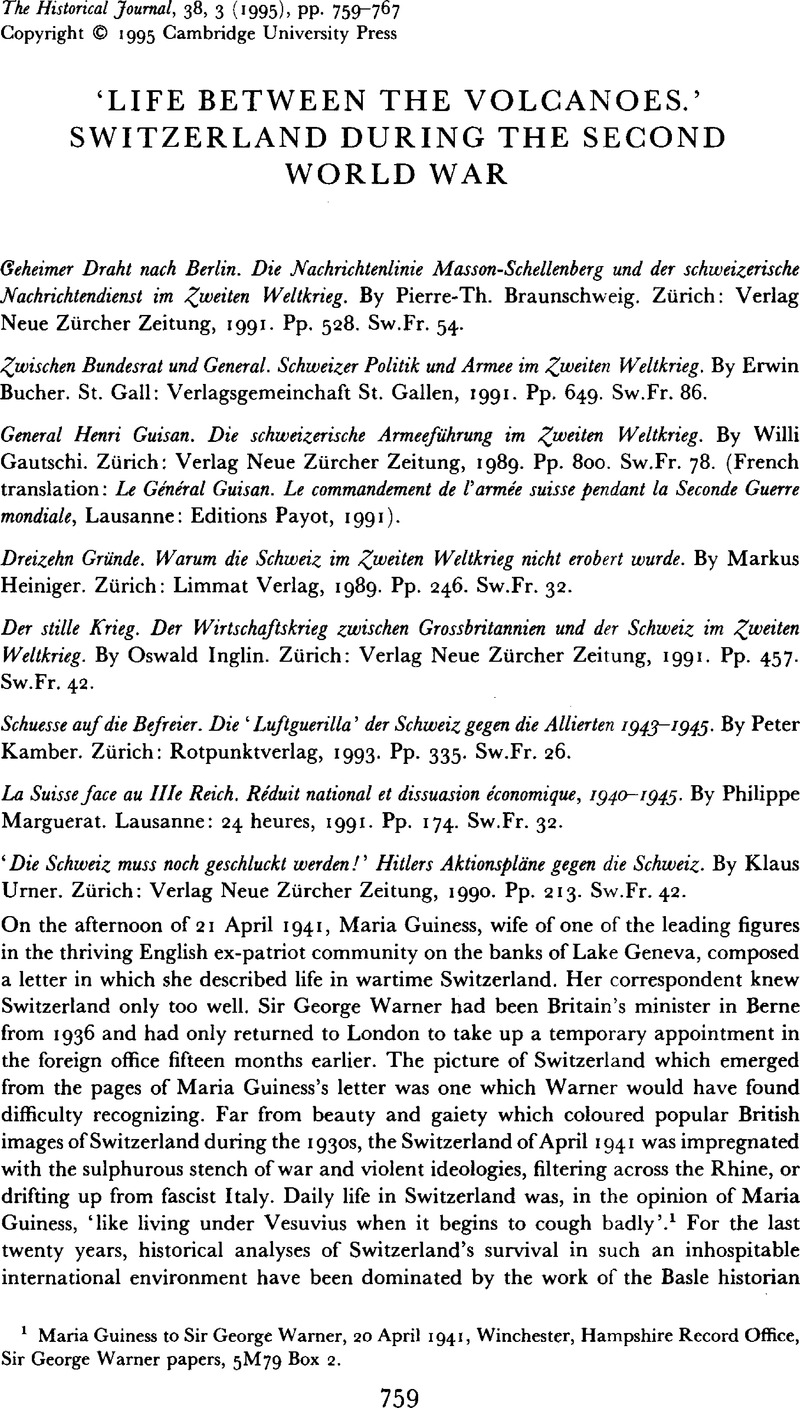No CrossRef data available.
Published online by Cambridge University Press: 11 February 2009

1 Maria Guiness to Sir George Warner, 20 April 1941, Winchester, Hampshire Record Office, Sir George Warner papers, 5M79 Box 2.
2 Edgar, Bonjour, Geschichte der schweizerischen Neutralität. Vier Jahrhunderte eidgenössischer Aussenpolitik (6 vols., Basle, 1970)Google Scholar. The relevant volumes for the war years are 4 to 6. French translation by Oser, C., Histoire de la neutralité suisse (Neuchâtel, 1970).Google Scholar
3 For a thorough analysis of Bonjour's work see Klaus, Urner, ‘Der Bonjour-Bericht in der Zeitgeschichte Kontroverse’, Parts I, II, III, Schweizer Monatshefte (1970), 74–83, 367–73, 610–20.Google Scholar
4 The standard work on these fascinating discussions is Georg, Kreis, Auf den Spuren von La Charité. Die schweizerische Armeeführung um Spannungsfeld des deutsch-französischen Gegmsatzes 1939–1941 (Basle, 1976).Google Scholar
5 The Allies had no intention of bringing Switzerland into the war, except in the case of a German invasion.
6 For earlier treatments of this issue, see Hans, Rudolf Kurz, Operationsplannung Schweiz. Die Rolle der Schweizer Armee in zwei Weltkriegen (Thun, 1974)Google Scholar, and Werner, Roesch, Bedröhte Schweiz. Die Operationsplannungen gegen die Schweiz im Sommer/Herbst 1940 und die Abwehrbereitschaft der Armee im Oktober 1940 (Frauenfeld, 1986).Google Scholar
7 The best surveys of Swiss financial activities during the war remain Marco, Durrer, Die schweizerisch-amerikanischen Finanzbeziehungen im zweiten Weltkrieg (Berne, 1984)Google Scholar. Marc, Perrenoud, ‘Banques et diplomatie suisses à la fin de la Deuxième Guerre Mondiale’, Studien und Quellen, XIII (1987), 5–124.Google Scholar
8 For earlier studies see Hans, Rudolf Kurz, Nachrictenzentrum Schweiz. Die Schweiz im Nachrichtendienst des zweiten Weltkrieges (Frauenfeld, 1972)Google Scholar. Hitherto surveys of ‘intelligence’ in Switzerland centred on the Soviet ‘Lucy’ spy ring, and the extent to which the other intelligence agencies interacted with this network. See for example Josef, Garlinski, The Swiss corridor (London, 1981)Google Scholar. For an appraisal of the Lucy ring's wider significance see Christopher, Andrew & Oleg, Gordievsky, KGB. The inside story of its foreign operations from Lenin to Gorbachev (London, 1990), 224–5.Google Scholar
9 The issue was first raised in a sensational way by Jon, Kimche's, Spying for peace; General Guisan and Swiss neutrality (London, 1960).Google Scholar
10 Report by Col. Wheeler, Military Attache's Staff, Berne. Cited in Crockatt (MI9) to Deputy Director of Military Intelligence (Prisoners of War), 23 Sept. 1943. Public Record Office, Kew WO32/10731.
11 William, Norton Medlicott, The economic blockade (2 vols., London, 1952).Google Scholar
12 For details on Hausamann and his intelligence network, Büro Ha, see Alphons, Matt, Zwischm alien Fronten. Der Zweiten Weltkrieg aus der Sicht des Büros Ha (Frauenfeld, 1969)Google Scholar, and Claude, Hauser, ‘Aux origines du “Büro Ha”: l'action de la Société suisse des officiers dans la campagne pour la révision de la loi militaire fédérate 24 février 1935’, Schweizerische Zeitschrift für Geschichte, XLIV (1994), 144–65.Google Scholar
13 In his earlier work Bucher did much to develop his thesis for the early war years, especially in describing the atmosphere in Switzerland after the fall of France, and in analysing Pilet's contribution to the Presidential radio address of 25 June 1940. See ‘Die Schweiz im Sommer 1940. Urteilmasstabe. Der Fall Pilet’, Schweizerische Zeitschrift für Geschichte, XXIX (1979), 356–98Google Scholar; ‘Die bundesrätliche Ansprache vom 25. Juni 1940’, Schweizerische geitschrift für Geschichte, XXXIX (1989), 422–44.Google Scholar